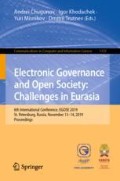Abstract
The paper describes theoretical peculiarities of e-government technology introduction in suburbanized areas in the medical care of the population. The purpose of the paper is to analyze the causes, factors, characteristics and conditions of the introduction of e-government technologies in the suburban areas. The distinctive features in the needs of the population of urbanized areas of their behavioral attitudes when accessing e-government services. The study is based on the example of medical services provided to the population in the framework of the public health system in Russia.
Access this chapter
Tax calculation will be finalised at checkout
Purchases are for personal use only
References
Homsy, G.C., Warner, M.E.: Cities and sustainability: polycentric action and multilevel governance. Urban Aff. Rev. 51(1), 46–73 (2015)
Duany, A., Plater-Zyberk, E., Speck, J.: Suburban Nation: The Rise of Sprawl and the Decline of the American Dream. North Point Press, Macmillan, New York (2011)
Government Services Portal of Russian Federation. https://www.gosuslugi.ru/
Summary of the sample survey “the Influence of behavioral factors on the health of the population”. Federal state statistics service (2008). http://www.gks.ru/free_doc/2008/demo/zdr08.htm. Accessed 07 Apr 2018
Poudel, S.K., et al.: District health service management. J-GMC-N 12(01), 75–78 (2019)
Suburbanization and improving the quality of life in the United States: from suburbs to outlying cities (2016). https://urban.hse.ru/suburbanization/. Accessed 07 Apr 2018. (in Russian)
McCrory, J.: The Edge City Fallacy. New Urban Form or Same Old Megalopolis? (2016). http://johnmccrory.com/selected-writings/the-Edge%20City-fallacy/. Accessed 07 Apr 2018
Hayden, D.: A Field Guide to Sprawl. W. W. Norton & Co., New York (2004)
Freilich, R.H., et al.: From Sprawl to Sustainability, Smart Growth, New Urbanism, Green Development and Renewable Energy. https://encrypted.google.com/books?id=2hET5BF4jDYC&printsec=frontcover&source=gbs_ViewAPI#v=onepage&q&f=false. Accessed 07 Apr 2018
Lewinnek, E.: The Working Man’s Reward: Chicago’s Early Suburbs and the Roots of American Sprawl. Oxford University Press, Oxford (2014)
Glaeser, E.: Triumph of the City, p. 400. The Random House, New York (2011)
Duany, A., Plater-Zyberk, E., Speck, J.: Suburban Nation: The Rise of Sprawl and the Decline of the American Dream, p. 293. North Point Press, Macmillan, New York (2011)
Garreau, J.: Edge City: Life on the New Frontier, p. 548. Anchor books, New York City (1991)
Remezkova, V., Gutkovich, V., Spirina, M.: Russia’s way to suburbanization: Moscow and Saint Petersburg experience. Urban Stud. Pract. 1(1), 24–37, 27 (2016)
Agha, L.: The effects of health information technology on the costs and quality of medical care. J. Health Econ. 34, 19–30 (2014)
Yen, K.: Time motion study in a pediatric emergency department before and after computer physician order entry. Ann. Emerg. Med. 53(4), 463 (2009)
Asaro, P.: Effects of computerized provider order entry and nursing documentation on workflow. Acad. Emerg. Med. 15(10), 911 (2008)
Tierney, W.: Physician inpatient order writing on microcomputer workstations: effects on resource utilization. J. Am. Med. Assoc. 269(3), 379 (1993)
McDowell, I.: A randomized trial of computerized reminders for blood pressure screening in primary care. Med. Care 27(3), 297 (1989)
McDowell, I.: Computerized reminders to encourage cervical screening in family practice. J. Fam. Pract. 28(4), 422 (1989)
Rosser, W.: Use of reminders to increase compliance with tetanus booster vaccination. CMAJ 146(6), 915 (1992)
McDowell, I.: Comparison of three methods of recalling patients for influenza vaccination. CMAJ 135(9), 994 (1986)
Rosser, W.: Use of reminders for preventive procedures in family medicine. CMAJ 145(7), 811 (1991)
Apkon, M., Singhaviranon, P.: Impact of an electronic information system on physician workflow and data collection in the intensive care unit. Intensive Care Med. 27(1), 128 (2001)
Overhage, J.: Controlled trial of direct physician order entry: effects on physicians’ time utilization in ambulatory primary care internal medicine practices. J. Am. Med. Inform. Assoc. 8, 364 (2001)
Pizziferri, L.: Primary care physician time utilization before and after implementation of an electronic health record: a time-motion study. J. Biomed. Inform. 38(3), 183 (2005)
Poissant, L.: The impact of electronic health records on time efficiency of physicians and nurses: a systematic review. J. Am. Med. Inform. Assoc. 12(5), 510 (2005)
Maslove, D.: Computerized physician order entry in the critical care environment: a review of current literature. J. Intensive Care Med. 26(3), 168 (2011)
Ballermann, M.: Impact of a critical care clinical information system on interruption rates during intensive care nurse and physician documentation tasks. In: MEDINFO, Amsterdam, 275 p. (2010)
Goorman, E.: Modelling nursing activities: electronic patient records and their discontents. Nurs. Inq. 7, 7 (2016)
Management Consulting: Rendering of government and municipal services rendering in Saint Petersburg multifunctional centers of public and municipal services, May 2015
Acknowledgements
This work is financially supported by the Ministry of Education and Science of the Russian Federation, Agreement #14.575.21.0161 (26/09/2017). Unique Identification RFMEFI57517X0161.
Author information
Authors and Affiliations
Corresponding author
Editor information
Editors and Affiliations
Rights and permissions
Copyright information
© 2020 Springer Nature Switzerland AG
About this paper
Cite this paper
Repkin, A.I., Yumaeva, N., Mityagin, S.A. (2020). Features of the E-government Technologies Introduction in the Medical Care in the Suburban Areas. In: Chugunov, A., Khodachek, I., Misnikov, Y., Trutnev, D. (eds) Electronic Governance and Open Society: Challenges in Eurasia. EGOSE 2019. Communications in Computer and Information Science, vol 1135. Springer, Cham. https://doi.org/10.1007/978-3-030-39296-3_16
Download citation
DOI: https://doi.org/10.1007/978-3-030-39296-3_16
Published:
Publisher Name: Springer, Cham
Print ISBN: 978-3-030-39295-6
Online ISBN: 978-3-030-39296-3
eBook Packages: Computer ScienceComputer Science (R0)

